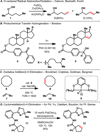Guided desaturation of unactivated aliphatics
- PMID: 22824894
- PMCID: PMC3405363
- DOI: 10.1038/nchem.1385
Guided desaturation of unactivated aliphatics
Abstract
The excision of hydrogen from an aliphatic carbon chain to produce an isolated olefin (desaturation) without overoxidation is one of the most impressive and powerful biosynthetic transformations for which there are no simple and mild laboratory substitutes. The versatility of olefins and the range of reactions they undergo are unsurpassed in functional group space. Thus, the conversion of a relatively inert aliphatic system into its unsaturated counterpart could open new possibilities in retrosynthesis. In this article, the invention of a directing group to achieve such a transformation under mild, operationally simple, metal-free conditions is outlined. This 'portable desaturase' (Tz(o)Cl) is a bench-stable, commercial entity (Aldrich, catalogue number L510092) that is facile to install on alcohol and amine functionalities to ultimately effect remote desaturation, while leaving behind a synthetically useful tosyl group.
Figures




Similar articles
-
Alkyl halides as both hydride and alkyl sources in catalytic regioselective reductive olefin hydroalkylation.Nat Commun. 2020 Nov 17;11(1):5857. doi: 10.1038/s41467-020-19717-6. Nat Commun. 2020. PMID: 33203895 Free PMC article.
-
Palladium-catalyzed aryl C-H olefination with unactivated, aliphatic alkenes.J Am Chem Soc. 2014 Oct 1;136(39):13602-5. doi: 10.1021/ja5082734. Epub 2014 Sep 19. J Am Chem Soc. 2014. PMID: 25188679
-
CuH-Catalyzed Olefin Functionalization: From Hydroamination to Carbonyl Addition.Acc Chem Res. 2020 Jun 16;53(6):1229-1243. doi: 10.1021/acs.accounts.0c00164. Epub 2020 May 13. Acc Chem Res. 2020. PMID: 32401530 Free PMC article.
-
Palladium-Catalyzed Directed meta-Selective C-H Allylation of Arenes: Unactivated Internal Olefins as Allyl Surrogates.Angew Chem Int Ed Engl. 2019 Jul 22;58(30):10353-10360. doi: 10.1002/anie.201904608. Epub 2019 Jun 24. Angew Chem Int Ed Engl. 2019. PMID: 31125484 Review.
-
Transition Metal-Catalyzed Dicarbofunctionalization of Unactivated Olefins.Chem Rec. 2018 Sep;18(9):1314-1340. doi: 10.1002/tcr.201700098. Epub 2018 Mar 8. Chem Rec. 2018. PMID: 29517841 Review.
Cited by
-
Second-Generation Palladium Catalyst System for Transannular C-H Functionalization of Azabicycloalkanes.J Am Chem Soc. 2018 Apr 25;140(16):5599-5606. doi: 10.1021/jacs.8b02142. Epub 2018 Apr 13. J Am Chem Soc. 2018. PMID: 29652497 Free PMC article.
-
Dehydrogenative synthesis of N-functionalized 2-aminophenols from cyclohexanones and amines: Molecular complexities via one-shot assembly.Sci Adv. 2024 May 3;10(18):eadn7656. doi: 10.1126/sciadv.adn7656. Epub 2024 May 1. Sci Adv. 2024. PMID: 38691610 Free PMC article.
-
Recent Advances in Rapid Synthesis of Non-proteinogenic Amino Acids from Proteinogenic Amino Acids Derivatives via Direct Photo-Mediated C-H Functionalization.Molecules. 2020 Nov 12;25(22):5270. doi: 10.3390/molecules25225270. Molecules. 2020. PMID: 33198166 Free PMC article. Review.
-
Aerobic dehydrogenation of cyclohexanone to cyclohexenone catalyzed by Pd(DMSO)2(TFA)2: evidence for ligand-controlled chemoselectivity.J Am Chem Soc. 2013 Jun 5;135(22):8205-12. doi: 10.1021/ja4031648. Epub 2013 May 24. J Am Chem Soc. 2013. PMID: 23662700 Free PMC article.
-
Alkane desaturation by concerted double hydrogen atom transfer to benzyne.Nature. 2013 Sep 26;501(7468):531-4. doi: 10.1038/nature12492. Nature. 2013. PMID: 24067712 Free PMC article.
References
-
- Larock RC. Comprehensive Organic Transformation. New York: Wiley; 1999.
-
- Choi J, MacArthur AHR, Brookhart M, Goldman AS. Dehydrogenation and Related Reactions Catalyzed by Iridium Pincer Complexes. Chem. Rev. 2011;111:1761–1779. - PubMed
-
- Breslow R, et al. Remote oxidation of steroids by photolysis of attached benzophenone groups. J. Am. Chem. Soc. 1973;95:3251–3262. - PubMed
-
- Breslow R. Biomimetic Chemistry and Artificial Enzymes: Catalysis by Design. Acc. Chem. Res. 1995;28:146–153.
Grants and funding
LinkOut - more resources
Full Text Sources
Other Literature Sources

